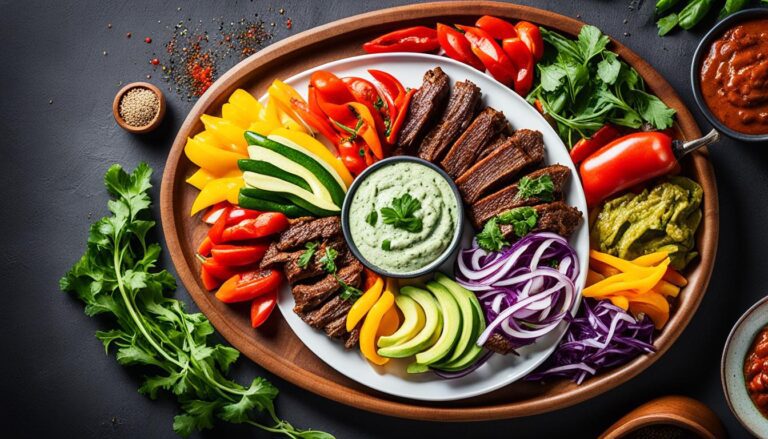Is Ethiopian Food Bad for You?
Have you ever wondered if Ethiopian food is bad for your health? Join us as we delve into the depths of this culture-rich cuisine to unravel the truth. From its diverse flavors to the unique ingredients, Ethiopian cuisine has captivated the taste buds of many. But does it come at a cost?
Many people associate bold spices and carb-heavy dishes with potential health risks. But is there more to Ethiopian food than meets the eye? We’re here to challenge common beliefs and uncover the truth about this vibrant culinary tradition.
Get ready to explore the nutritional benefits, traditional ingredients, health considerations, and potential risks of Ethiopian food. Together, we’ll find out how to strike the perfect balance and make the most of this exotic cuisine without compromising our well-being.
Key Takeaways:
- Discover the nutritional benefits of Ethiopian food and how it can contribute to a balanced diet.
- Learn about the traditional ingredients used in Ethiopian cooking and how they add flavor and healthiness to the dishes.
- Understand the potential health considerations associated with Ethiopian food, such as spice levels, portion sizes, and specific dietary restrictions.
- Explore the potential risks of consuming Ethiopian food, including foodborne illnesses and allergies, and how to mitigate these risks.
- Discover strategies for incorporating Ethiopian food into a healthy diet, including portion control, meal planning, and diversifying food choices.
Nutritional Benefits of Ethiopian Food
Ethiopian cuisine, with its diverse flavors and unique ingredients, offers more than just a delicious dining experience. It also provides numerous nutritional benefits that can contribute to a balanced diet.
One of the standout features of Ethiopian food is the abundant use of spices and aromatic herbs. These ingredients not only enhance the flavors of the dishes but also offer various health-promoting properties. Spices like turmeric, cumin, and cardamom have been associated with anti-inflammatory and antioxidant effects, which can help boost the immune system and protect against chronic diseases.
In addition to spices, Ethiopian cuisine incorporates a variety of vegetables, legumes, and whole grains. These plant-based ingredients are rich in dietary fiber, vitamins, and minerals, making Ethiopian dishes a nutritious choice. Lentils, chickpeas, and split peas are commonly used in stews and lentil-based dishes, offering a good source of plant-based protein and fiber.
One iconic dish of Ethiopian cuisine is injera, a sourdough flatbread made from teff flour. Teff is a gluten-free grain that is high in iron, calcium, and resistant starch, providing sustained energy and supporting digestive health.
Another nutritional advantage of Ethiopian food is its emphasis on communal dining. Sharing a platter with family and friends encourages portion control and mindful eating, allowing individuals to savor the flavors and experience a sense of togetherness.
Incorporating Ethiopian cuisine in your diet can introduce a variety of flavors, textures, and nutrients, promoting overall health and well-being. Whether you’re a fan of spiced vegetables, flavorful stews, or protein-rich legumes, Ethiopian food offers something for everyone.
Continue reading to explore the traditional ingredients used in Ethiopian cooking and how they contribute to the overall flavor and healthiness of the dishes.
Traditional Ethiopian Ingredients
Ethiopian cuisine is renowned for its rich flavors and unique culinary traditions. One of the defining aspects of Ethiopian cooking is the use of traditional ingredients that contribute to the distinct taste and healthiness of the dishes.
One key ingredient is teff, a grain native to Ethiopia and the foundation of injera, a sourdough flatbread that serves as a staple in Ethiopian meals. Teff is not only gluten-free but is also packed with essential nutrients like iron, calcium, and fiber.
Another prominent ingredient in Ethiopian cuisine is berbere, a blend of spices that adds depth and heat to various dishes. Berbere typically consists of chili peppers, garlic, ginger, fenugreek, and a combination of aromatic spices. This spice blend not only imparts a distinct flavor but also offers potential health benefits such as anti-inflammatory properties.
The use of legumes is also prevalent in Ethiopian cooking. Chickpeas and lentils are often featured in stews and curries, providing a good source of protein, fiber, and essential minerals.
Additionally, niter kibbeh, a spiced clarified butter, is a fundamental ingredient in Ethiopian cuisine. It is made by simmering butter with various spices such as ginger, garlic, and cardamom. Niter kibbeh adds richness and complexity to dishes, while the spices used contribute to potential health benefits.
The combination of these traditional ingredients, along with a variety of vegetables, herbs, and meats, creates a harmonious blend of flavors that characterize Ethiopian cuisine. Beyond their taste, these ingredients offer unique nutritional profiles, making Ethiopian food both satisfying and nourishing.
Health Considerations and Ethiopian Food
When it comes to Ethiopian food, there are various health considerations to keep in mind. From the spice levels to portion sizes and specific dietary restrictions, understanding these factors is essential for enjoying this cuisine while maintaining a balanced diet.
Ethiopian food is known for its bold flavors and the liberal use of spices and herbs. While this adds depth and complexity to the dishes, it’s important to be mindful of spice levels, especially if you have a sensitive stomach or certain health conditions. Adjusting the spice level to your preference or opting for milder dishes can help ensure a pleasant and healthy dining experience.
Portion sizes are another crucial aspect to consider. Ethiopian meals are traditionally served family-style on a shared platter with injera, a sourdough flatbread. It’s easy to get carried away and indulge in large portions, but practicing portion control is key. Be mindful of your hunger cues and try to listen to your body’s signals to avoid overeating.
If you have specific dietary restrictions or preferences, it’s important to communicate them when dining at Ethiopian restaurants. Many Ethiopian dishes are naturally gluten-free, making them a great option for individuals with celiac disease or gluten sensitivity. However, some dishes may contain ingredients like wheat flour or barley, so it’s essential to inquire about the ingredients and preparation methods to ensure they align with your dietary needs.

Allergies and Ethiopian Cuisine
It’s also important to be mindful of potential allergens when consuming Ethiopian food. Some dishes may contain common allergens like peanuts, tree nuts, dairy, eggs, or shellfish. If you have known food allergies, it’s crucial to communicate them to the restaurant staff to avoid any adverse reactions. Most Ethiopian restaurants are accommodating and will provide alternative options or suggest dishes that meet your dietary requirements.
By staying aware of spice levels, portion sizes, and any specific dietary restrictions or allergies, you can enjoy the unique flavors and culinary experience that Ethiopian food offers while prioritizing your health and well-being.
Potential Risks of Ethiopian Food
While Ethiopian cuisine is undoubtedly delicious and nutritious, it’s important to be aware of and address any potential risks associated with consuming this cultural delight. This section will explore some of the potential risks that may arise when enjoying Ethiopian food and provide tips on how to mitigate them.
Foodborne Illnesses: As with any cuisine, there is a risk of foodborne illnesses when consuming Ethiopian food. These can be caused by improper food handling, inadequate storage, or contaminated ingredients. It is crucial to ensure that the food is prepared and stored hygienically, cooked thoroughly, and served at the right temperature to minimize the risk of foodborne illnesses.
Allergies and Sensitivities: Ethiopian cuisine often incorporates a variety of spices, herbs, and ingredients that may trigger allergies or sensitivities in some individuals. Common allergens include peanuts, sesame seeds, and various spices. If you have known allergies or sensitivities, it’s important to communicate your dietary restrictions to the restaurant or chef, and carefully review the menu for potential allergens.
To mitigate these risks, it is advisable to dine at reputable Ethiopian restaurants that prioritize food safety and cleanliness. Additionally, communicating any dietary restrictions or allergies to the restaurant staff can help them accommodate your needs and provide alternative options if necessary. Being vigilant about food handling and storage practices at home when preparing Ethiopian dishes can also minimize the risk of foodborne illnesses.

Balancing Ethiopian Food in a Healthy Diet
When it comes to maintaining a healthy diet, incorporating diverse cuisines can be both enjoyable and beneficial. Ethiopian cuisine offers a unique and flavorful experience that can be part of a balanced eating plan.
One key strategy for balancing Ethiopian food in a healthy diet is practicing portion control. Ethiopian dishes are often served in communal platters and shared among diners, which can lead to overeating. To avoid consuming excessive calories, it’s important to be mindful of your portion sizes and listen to your body’s hunger cues.
Meal planning is another helpful approach to ensure a healthy balance. By incorporating Ethiopian dishes into your meal plan, you can prioritize nutrient-dense options like lentils, vegetables, and lean protein sources. This will not only add variety to your diet but also provide important vitamins, minerals, and fiber.
Emphasizing diversity in your food choices is also essential. While Ethiopian cuisine offers a wide range of vegetarian and vegan options, it’s important to incorporate other food groups into your meals. Include whole grains, fruits, and healthy fats to create a well-rounded eating plan that meets your nutritional needs.
By following these strategies, you can enjoy the unique flavors of Ethiopian food while maintaining a healthy diet. Remember, moderation is key, and it’s important to consider your individual health needs and goals when incorporating any cuisine into your eating plan.
Conclusion
We have explored the topic of whether Ethiopian food is bad for you. Throughout our journey, we have discovered that while there may be some risks and considerations, overall, Ethiopian cuisine can be enjoyed as part of a balanced and healthy diet. The rich flavors and diverse ingredients found in Ethiopian food contribute to its nutritional benefits.
By incorporating traditional Ethiopian ingredients into your meals, you can experience a variety of flavors while also reaping the health benefits they offer. From nutrient-rich legumes like lentils and chickpeas to the vibrant spices that add both flavor and potential health benefits, Ethiopian food can be a nutritious addition to your culinary repertoire.
As with any cuisine, it is important to consume Ethiopian food in moderation and pay attention to individual health needs. Consideration of portion sizes, spice levels, and any dietary restrictions or allergies is crucial for maintaining a balanced diet. With proper planning, Ethiopian food can be enjoyed alongside other healthy food choices and contribute to a well-rounded eating pattern.
In conclusion, while there are some factors to consider when it comes to Ethiopian food, it can be a delicious and nutritious addition to your diet. By being mindful of portion sizes and individual health needs, you can savor the unique flavors of this culture-rich cuisine without compromising your well-being. Embrace the vibrant spices and traditional ingredients of Ethiopian food to enhance your culinary experiences while maintaining a balanced and healthy lifestyle.







